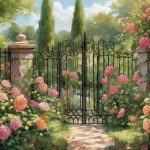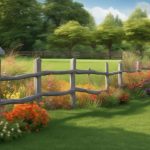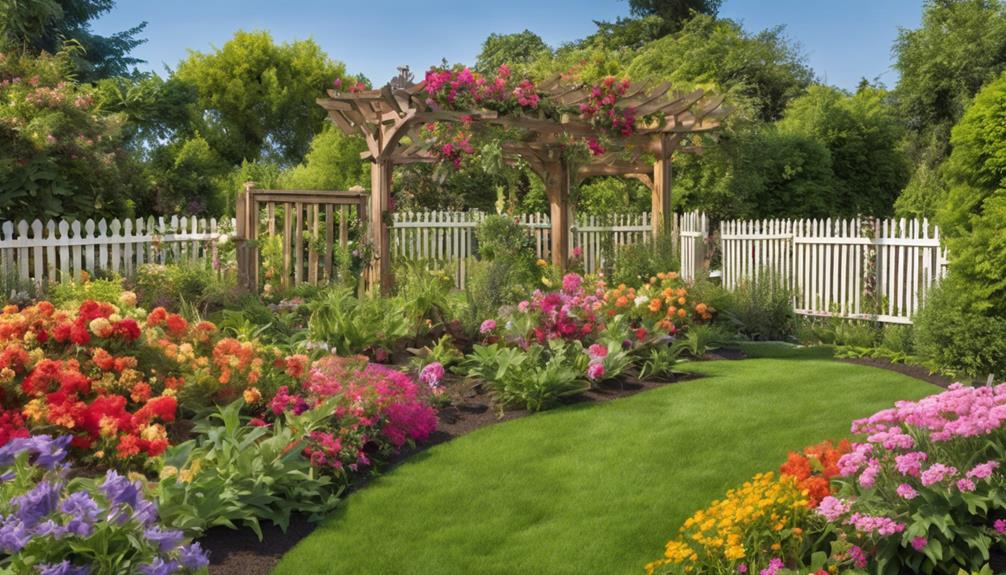
Why Fencing Elevates Your Garden’s Beauty?
22 September 2024
Installing Garden Fencing for Wind Protection
23 September 2024To optimise seasonal fencing installation for gardens, focus on three essential aspects.
Firstly, choose weather-resistant materials such as treated timber or vinyl for durability against seasonal elements.
Secondly, plan your fence layout considering garden dimensions and existing features to enhance both aesthetics and functionality.
Finally, schedule the installation during dry periods to ensure soil stability and minimise damage.
These tips will protect your garden while enhancing its visual appeal and longevity.
For further insights into maximising your garden fencing strategy, explore additional considerations and techniques that can elevate your installation approach.
Seasonal Fencing Benefits Explained
Seasonal fencing offers significant benefits for garden maintenance, primarily by providing enhanced protection against pests and environmental factors.
Furthermore, these installations can elevate the aesthetic appeal of a garden, creating a visually pleasing transformation with the changing seasons.
Understanding these advantages can assist homeowners in making informed decisions regarding their garden fencing requirements.
Enhanced Garden Protection
Implementing seasonal fencing can greatly enhance the protection of your garden against a variety of threats. By establishing a physical barrier, you effectively deter pests, such as rabbits and deer, which can devastate your plants.
Additionally, seasonal fencing shields your garden from harsh weather conditions, minimising damage from strong winds and heavy snowfall. Opting for materials that withstand the elements guarantees longevity and durability, providing year-round security.
Furthermore, properly installed fencing can prevent soil erosion and safeguard delicate root systems during seasonal changes. This proactive measure not only protects your investment in gardening but also improves the overall health of your plants.
Mastering the art of seasonal fencing is crucial for any serious gardener aiming to cultivate a thriving garden environment.
Aesthetic Seasonal Appeal
A well-designed fence not only serves as a protective barrier but also enhances the visual appeal of your garden throughout the year.
Seasonal fencing allows for creative expression and adaptability, enabling you to harmonise your landscape with the changing seasons. For instance, wooden fences can be refreshed with seasonal paint or stains to reflect autumnal hues, while lattice designs can support climbing plants that thrive in summer.
In winter, evergreen vines can provide a backdrop of greenery, creating a striking contrast against the snow.
Moreover, the selection of materials—such as wrought iron or vinyl—can complement various garden styles, from rustic to contemporary.
Ultimately, a thoughtfully installed fence improves not only the aesthetics but also the overall ambience of your outdoor space, fostering a cohesive design.
Material Durability Considerations
When selecting materials for seasonal fencing, it is essential to consider their weather resistance properties, as this directly impacts longevity and maintenance requirements.
Furthermore, the aesthetic appeal of the fencing can enhance the overall garden design, making material choice a key factor in achieving the desired visual outcomes.
Ultimately, evaluating cost-effectiveness over time ensures that the investment in fencing aligns with both budgetary constraints and long-term durability expectations.
Weather Resistance Properties
Choosing the right materials for your garden fence is crucial, especially as seasonal weather conditions can greatly impact durability and longevity.
To ensure your fence withstands the elements, consider the following weather resistance properties:
- Moisture Resistance: Opt for materials such as vinyl or treated timber that can repel water, preventing rot and decay.
- UV Stability: Select UV-resistant options, such as composite materials, to protect against sun damage and fading, maintaining structural integrity.
- Wind Tolerance: Choose robust designs and materials, such as metal or heavy-duty timber, that can endure high winds, reducing the risk of damage during storms.
Aesthetic Appeal of Fencing
The aesthetic appeal of fencing plays a significant role in enhancing the overall appearance of a garden while also serving practical purposes.
Selecting materials that resonate with the garden's design can elevate its visual identity. When considering material durability, focus on the following key aspects:
- Material Selection: Choose materials such as vinyl or metal that maintain their appearance over time and resist fading.
- Colour Coordination: Opt for colours that complement or contrast with your garden's palette, creating a harmonious environment.
- Design Compatibility: Ensure that the fencing style—be it modern, rustic, or traditional—aligns with the overall theme of the garden, thereby enhancing its character.
A well-chosen fence not only enriches the garden's aesthetics but also reinforces its structure and purpose.
Cost-Effectiveness Over Time
Investing in high-quality fencing materials can yield significant cost savings over time by minimising maintenance and replacement expenses.
Durable materials not only enhance the longevity of your fencing but also reduce the frequency of repairs, ensuring that your garden remains protected without constant investment.
Consider the following factors when evaluating material durability:
- Material Composition: Choose materials such as vinyl, aluminium, or treated wood, which are known for their resistance to weathering and pests.
- Warranty Coverage: Opt for products with comprehensive warranties, indicating the manufacturer's confidence in their longevity.
- Maintenance Requirements: Assess the upkeep needed; low-maintenance options may require less time and financial commitment over the years.
Planning Your Fence Layout
When planning your fence layout, it is crucial to assess the existing layout of your garden to ensure optimal placement.
Always prioritise quality materials to enhance durability and aesthetics, particularly when incorporating decorative fence panels.
A well-thought-out design not only defines your garden space but also complements its overall appearance.
Assess Your Garden's Layout
Effective planning is vital for a successful fencing installation in your garden. To achieve a well-coordinated fence layout, it is important to assess your garden's dimensions, features, and purpose.
Begin by considering the following factors:
- Garden Size: Measure the total area to determine how much fencing material will be required and to identify potential obstructions.
- Existing Features: Take note of trees, paths, and flower beds that may influence the fence's positioning and design.
- Intended Use: Define the primary purpose of the fence—whether for privacy, security, or aesthetic appeal—as this will inform your layout decisions.
Use Quality Materials Always
Choosing quality materials for your garden fence is vital to ensure durability and longevity. The right materials not only enhance the aesthetic appeal but also provide essential protection against the elements and pests.
When planning your fence layout, consider the following key factors:
- Material Type: Opt for treated timber, vinyl, or metal that can withstand weather conditions and resist decay.
- Gauge and Thickness: Select materials with appropriate gauge and thickness to ensure structural integrity and resistance to bending or breaking.
- Finish and Coatings: Invest in high-quality finishes or coatings that protect against rust, rot, and UV damage, thereby reducing maintenance costs over time.
Installing Decorative Fence Panels
In planning your fence layout, installing decorative fence panels can significantly enhance the visual appeal of your garden while providing a functional barrier.
To achieve the best results, consider the following steps:
- Assess Your Space: Evaluate the dimensions and topography of your garden to determine how many panels are required and their ideal positioning.
- Choose the Right Style: Select panels that complement the aesthetic of your garden. Options range from classic wooden designs to contemporary metal finishes.
- Plan for Maintenance: Consider the long-term care of your panels. Opt for materials that require minimal upkeep and are suitable for local weather conditions.
Enhanced Garden Privacy Options
Six effective options can significantly enhance privacy in your garden, creating a tranquil oasis away from the outside world. Consider implementing tall hedges, trellises adorned with climbing plants, or solid wooden fences. Additionally, utilising bamboo screens can provide an aesthetically pleasing barrier, while lattice panels enhance vertical space. For a creative approach, incorporating outdoor screens or curtains can offer flexible privacy solutions tailored to your needs.
| Option | Benefits | Considerations |
|---|---|---|
| Tall Hedges | Natural appearance, noise reduction | Requires regular maintenance |
| Climbing Plants | Aesthetic appeal | Growth time may vary |
| Solid Wooden Fence | Maximum privacy | Higher cost and installation effort |
| Bamboo Screens | Eco-friendly | Potential durability concerns |
| Outdoor Curtains | Versatile and movable | Seasonal adjustments may be necessary |
Garden Fence Design Strategies
Effective garden fence design strategies can greatly enhance both aesthetics and functionality within a landscape.
Incorporating vertical garden trellises, installing privacy screens, and utilising lighting options are key elements that can transform a garden space.
Vertical Garden Trellis Integration
Integrating vertical garden trellises into your fencing design can significantly enhance both the aesthetic and functional aspects of your garden space.
Trellises not only add visual interest but also support climbing plants, thereby boosting your garden's verticality and biodiversity.
Consider these strategies for effective integration:
- Select Complementary Materials: Choose trellises that harmonise with your fence's material—wood, metal, or composite—to create a cohesive look.
- Strategic Plant Selection: Opt for climbing plants that thrive in your climate and align with your garden's overall theme, ensuring they enhance rather than overpower your fence.
- Optimise Placement: Position trellises to maximise sunlight exposure while maintaining accessibility for maintenance and harvesting.
Vertical Privacy Screen Installation
In conjunction with enhancing aesthetics with vertical garden trellises, implementing vertical privacy screens can significantly improve the functionality and seclusion of your garden space.
These structures not only create a tranquil environment but also serve as a backdrop for climbing plants, enriching the overall design.
To ensure effective installation, consider the following strategies:
- Material Selection: Choose durable materials such as cedar, vinyl, or composite that can withstand weather conditions while complementing your garden style.
- Height and Placement: Opt for screens that are sufficiently high to provide privacy without overwhelming the garden. Position them strategically to block unwanted views.
- Integration with Landscaping: Incorporate the screens seamlessly into the landscape by surrounding them with lush plants or decorative elements, enhancing visual appeal and harmony.
Garden Fence Lighting Options
Often overlooked, garden fence lighting plays a crucial role in enhancing both safety and ambience in outdoor spaces.
The right lighting can transform your garden, making it more inviting while providing necessary illumination.
Here are three effective garden fence lighting options to consider:
- Solar-Powered Lights: Eco-friendly and cost-effective, these lights harness sunlight during the day to illuminate your garden at night.
- String Lights: Perfect for creating a warm, festive atmosphere, string lights can be easily draped along the fence for a charming effect.
- Wall-Mounted Fixtures: For a more permanent solution, consider installing wall-mounted fixtures that provide direct light and enhance security.
Incorporating these options will uplift your garden's aesthetic and functionality, ensuring a beautifully lit outdoor space.
Installation Timing Issues
Timing is crucial when installing garden fencing, as weather conditions can significantly affect the process.
Installing during dry seasons helps to prevent complications such as soil compaction, ensuring a stable foundation for your fence.
Proper planning around these factors will lead to a more successful and durable installation.
Weather-Appropriate Installation Timing
Selecting the right moment for garden fencing installation is crucial to ensuring a successful and durable structure. Weather conditions play a significant role in this process, as they can greatly affect the integrity of the installation.
To achieve optimal results, consider the following factors:
- Temperature Fluctuations: Avoid extreme temperatures that can compromise materials, such as freezing conditions or excessive heat.
- Ground Conditions: Ensure that the soil is neither overly wet nor frozen, as wet ground may lead to unstable posts, while frozen ground can hinder proper anchoring.
- Wind Patterns: Install fencing during periods of calm weather to prevent misalignment and to ensure safety during the process.
Install During Dry Seasons
For optimal results in garden fencing installation, scheduling the project during dry seasons is crucial.
Dry conditions promote the best soil stability and material integrity, ensuring a smooth installation process.
Consider the following advantages:
- Enhanced Material Performance: Fencing materials, such as wood and vinyl, are less susceptible to warping or cracking in stable, dry climates.
- Improved Ground Conditions: Firm, dry soil allows for easier digging and better anchoring, reducing the risk of post-shift occurring over time.
- Reduced Weather Disruptions: Installing in dry weather minimises delays caused by rain or muddy conditions, allowing for a more efficient project timeline.
Avoiding Soil Compaction Issues
Soil compaction can significantly impede the success of garden fencing installation, leading to structural issues and diminished longevity.
To avoid this problem, it is essential to adopt strategic practices that uphold soil integrity. Consider the following methods:
- Plan Installation Timing: Schedule installations during dry periods when the soil is less saturated, thereby minimising the risk of compaction.
- Utilise Proper Equipment: Employ lightweight tools and machinery. Heavy equipment can exacerbate compaction, particularly in wet or loose soils.
- Aerate the Soil: Prior to installation, aerate the soil to enhance drainage and reduce density, facilitating easier post-installation adjustments.
Why Choose TKL Birmingham Gardener
Homeowners frequently seek reliable and skilled gardening services to enhance their outdoor spaces, and TKL Birmingham Gardener stands out as an exceptional choice.
With a commitment to excellence, TKL Birmingham Gardener combines extensive expertise with a passion for horticulture, ensuring that each project is executed with precision. Their attention to detail is reflected in the meticulous planning and installation of seasonal fencing that complements the aesthetic of any garden.
Moreover, TKL employs sustainable practices that enhance the health of your outdoor environment. Their skilled team is adept at addressing diverse gardening needs, providing tailored solutions that resonate with both functionality and beauty.
Choosing TKL Birmingham Gardener means investing in quality and long-lasting results for your landscape.
Common Fence Installation Questions
When considering the installation of a seasonal fence, homeowners often have numerous questions that address both practical and aesthetic concerns.
Common inquiries include the ideal materials for varying climates and the durability of different fencing options. Homeowners frequently seek guidance on local zoning regulations and permit requirements, as non-compliance can lead to costly adjustments.
The installation process itself often raises questions about labour costs, timeframes, and whether to engage professional services or undertake a DIY approach.
Furthermore, concerns about maintenance and longevity of the fence are prevalent, especially regarding seasonal wear and the implications for garden aesthetics.
Addressing these questions thoroughly is crucial for making informed decisions that enhance both functionality and visual appeal in garden settings.
Finalizing Your Fence Choice
Finalising Your Fence Choice
After addressing common questions regarding fence installation, it is crucial to focus on the specifics of finalising your fence choice. Selecting the right fence involves careful consideration of multiple factors to ensure it complements your garden's aesthetic and functional needs.
Here are three key elements to guide your decision:
- Material Selection: Assess durability, maintenance, and appearance. Options include wood, vinyl, metal, and composite materials.
- Height and Style: Determine the appropriate height for privacy or decorative purposes, and choose a style that harmonises with your landscape.
- Local Regulations: Verify zoning laws and homeowners' association guidelines to avoid potential legal issues.




